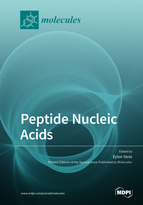Peptide Nucleic Acids: Applications in Biomedical Sciences
A special issue of Molecules (ISSN 1420-3049). This special issue belongs to the section "Chemical Biology".
Deadline for manuscript submissions: closed (31 December 2019) | Viewed by 45794
Special Issue Editor
Interests: PNA (peptide nucleic acid); FIT-PNA (forced-intercalation-PNA); CPP (cell penetrating peptides); RNA diagnostics, antisense
Special Issues, Collections and Topics in MDPI journals
Special Issue Information
Dear Colleagues,
Peptide Nucleic Acid (PNA) is a purely synthetic DNA analogue that has been used in the last three decades for a variety of biomedical applications. PNA consists of a pseudo-peptide backbone from which one of each of the possible four canonical bases (A, G, C, and T) is introduced in a way that allows highly efficient hybridization to complementary RNA or DNA sequences. PNA oligomers have several properties that make them suitable for use in the field of biology/medicine including (1) high stability in biological fluids, and (2) cell permeability by conjugation of PNA to a CPP (cell penetrating peptide), lipid, or ligand, and/or encapsulation into nano/micro particles.
As therapeutic molecules, PNAs have been developed as potent and specific antiviral and antimicrobial agents. In addition, they have been used to effect splicing events as a means of treating genetic disorders (e.g., Duchene Muscular Dystrophy). In addition, modified PNAs (e.g., gamma-PNAs) have been shown to act as potent antigene molecules (targeting dsDNA as well as dsRNA). In the diagnostic field, PNAs have been used to detect a variety of RNA biomarkers in living cells associated with diseases (e.g., cancer) and were also designed to detect single point mutations associated with certain diseases.
This Special Issue is intended to provide a platform to report advances and challenges in both the therapeutic and diagnostic fields associated with PNA chemistry. Specifically, perspectives related to PNA cellular uptake, bio-availability, specificity, sensitivity, and potency are welcomed, as are focused review articles by experts in the PNA field.
Dr. Eylon Yavin
Guest Editor
Manuscript Submission Information
Manuscripts should be submitted online at www.mdpi.com by registering and logging in to this website. Once you are registered, click here to go to the submission form. Manuscripts can be submitted until the deadline. All submissions that pass pre-check are peer-reviewed. Accepted papers will be published continuously in the journal (as soon as accepted) and will be listed together on the special issue website. Research articles, review articles as well as short communications are invited. For planned papers, a title and short abstract (about 100 words) can be sent to the Editorial Office for announcement on this website.
Submitted manuscripts should not have been published previously, nor be under consideration for publication elsewhere (except conference proceedings papers). All manuscripts are thoroughly refereed through a single-blind peer-review process. A guide for authors and other relevant information for submission of manuscripts is available on the Instructions for Authors page. Molecules is an international peer-reviewed open access semimonthly journal published by MDPI.
Please visit the Instructions for Authors page before submitting a manuscript. The Article Processing Charge (APC) for publication in this open access journal is 2700 CHF (Swiss Francs). Submitted papers should be well formatted and use good English. Authors may use MDPI's English editing service prior to publication or during author revisions.
Keywords
- PNA
- antisense
- antigene
- RNA/DNA diagnosis
- antiviral PNA
- antimicrobial PNA
- chemically modified PNA
- strand invasion







